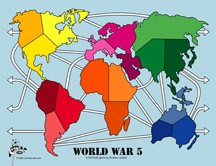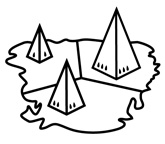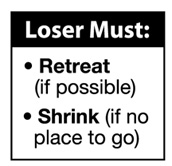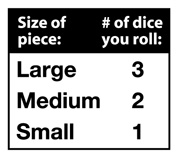 How to Play
World War 5
How to Play
World War 5
A 3HOUSE game by Andrew Looney
Equipment
You need 3 matching Treehouse sets and 6 regular dice along with the World War 5 gameboard.
Number of Players
2-4 players is recommended.
Goal
Conquer another continent while maintaining a base in your own continent. You are eliminated from the game if there are zero pieces of your color on your continent.
 Setup
Setup
Each player chooses a home continent and is issued nine pyramids (three of each size) of the color most similar to the colors of their continent.
Place three pyramids (one of each size) onto the three territories of your continent. Only one piece may ever occupy a territory.
Roll dice to see who will go first. Players add their pyramids to the board in turn order.
Turn Options
Perform one of these turn options each turn:
- GROW: Increase the size of one of your pyramids by replacing it with the next larger size, if one is available. You can only do this to a piece on your own continent.
- BUILD: Place a small pyramid of your color (if available) into an empty territory within your own continent.
- MOVE: Transfer one of your units to an empty territory that it is connected to.
- INVADE: Attempt to enter a connected enemy-held territory by using combat.
|
 |
Game Over
You win if all three territories in another colored continent are occupied by pieces of your color -- provided you also have at least one piece of your color in your home continent.
Credits
- Designed by: Andrew Looney
- Inspired by: Risk and Diplomacy
- Playtested by: Kristin, Alison, Shel West, Robin Vinopal, the Wunderland Toast Society
FAQ
- Q: During setup,
does each player put their pieces out one at a time, or all 3
at once?
- A: Unless it's a tournament or the players are super-competitive, player can put all three of their pieces onto their territories as one step. But if Death is on the line, players should take turns first placing their smalls, then their mediums, and lastly their larges.
- Q: Suppose a player who controls 2 sectors of a foreign continent mounts a successful attack on the third, allowing them to move in and claim victory. However, the loser also controls 2 sectors of a different foreign continent. They retreat to the empty sector and claim victory. Is this a tie? Who wins?
- A: As in Treehouse, if two players meet the victory condition at the same time, then the player whose move caused win is the winner.
- Q: If a small piece with no escape is attacked and beaten, and therefore removed from the board, does the attacking piece take the newly vacated space? The rules says that for attacks with no retreats, "the attackers piece does not move."
- A: Unfortunately, that rule is unclear. If the space is vacated, then the attacker gets to move in, regardless of why the space became empty.
- Q: All the board spaces for World War 5 connect to exactly 5 other spaces with the exception of "USA" and "Western Europe," which each connect to six; and "Alaska" and "Scandinavia," which each connect to four. Now, to make the board perfectly balanced, the only thing that would have to be done is remove the connection between USA and Western Europe and add a connection between Alaska and Scandinavia. Was there a design reason behind this single imbalance?
- A: Drawing that connection would have required a difficult-to-squeeze-on polar route, and after plenty of playtesting, Andy came to the conclusion that this tiny imbalance doesn't really matter. The key thing is the equal number of international connections, which is nine for all six continents. The fact that two of the continents have a bottleneck is compensated for by the matching floodgate, so that it makes no real difference.
- Q: Why can't 5 or 6 people play?
- A: Well, technically they can, since there are starting continents and pyramid colors available for that many players. However, without a couple of empty continents to fight over, someone must be eliminated from the game before anyone has a chance of winning, which makes for a longer game and therefore isn't recommended.
- A: Unless it's a tournament or the players are super-competitive, player can put all three of their pieces onto their territories as one step. But if Death is on the line, players should take turns first placing their smalls, then their mediums, and lastly their larges.
 Combat
Combat



